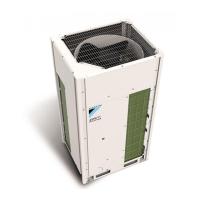46English
17.3.1. Vacuuming method
1 9JGPVJGWPKVKUCVUVCPFUVKNNUGVVJGWPKVKP=?
2 9JGPEQPƂTOGFVJGKPFQQTWPKVUVJG$TCPEJ5GNGEVQTWPKVUCPF
QWVFQQTWPKVGZRCPUKQPXCNXGUYKNNHWNN[QRGP#VVJCVOQOGPV
the segment display indication=
01 and the user interface of
all indoor units indicate “Test Operation” and
CENTRAL
CONTROL
and the
operation will be prohibited.
3 Evacuate the system with a vacuum pump.
4 Press BS3 to stop vacuuming mode.
17.3.2. Refrigerant recovery operation method
This should be done by a refrigerant recovery equipment. Follow the
same procedure as for vacuuming method.
18. Caution for refrigerant leaks
18.1. Introduction
The installer and system specialist shall secure safety against
leakage according to local regulations or standards. The following
standards may be applicable if local regulations are not available.
The VRV System, like other air conditioning systems, uses R410A as
TGHTKIGTCPV4#KVUGNHKUCPGPVKTGN[UCHGPQPVQZKEPQPEQODWUVKDNG
refrigerant. Nevertheless care must be taken to ensure that air con-
FKVKQPKPIHCEKNKVKGUCTGKPUVCNNGFKPCTQQOVJCVKUUWHƂEKGPVN[NCTIG6JKU
CUUWTGUVJCVVJGOCZKOWOEQPEGPVTCVKQPNGXGNQHTGHTKIGTCPVICUKUPQV
GZEGGFGFKPVJGWPNKMGN[GXGPVQHOCLQTNGCMKPVJGU[UVGOCPFVJKUKP
accordance to the local applicable regulations and standards.
Maximum concentration level
6JGOCZKOWOEJCTIGQHTGHTKIGTCPVCPFVJGECNEWNCVKQPQHVJGOCZK-
mum concentration of refrigerant is directly related to the humanly
occupied space in to which it could leak.
The unit of measurement of the concentration is lbs./ft.
3
(kg/m
3
) (the weight in
lbs. (kg) of the refrigerant gas in 1 ft.
3
(1 m
3
) volume of the occupied space).
Compliance to the local applicable regulations and standards for the
OCZKOWOCNNQYCDNGEQPEGPVTCVKQPNGXGNKUTGSWKTGF
2
1
1 &KTGEVKQPQHVJGTGHTKIGTCPVƃQY
2 4QQOYJGTGTGHTKIGTCPVNGCMJCUQEEWTTGFQWVƃQYQHCNN
the refrigerant from the system).
Pay special attention to places, such as basements etc., where
refrigerant could stay, since refrigerant is heavier than air.
Procedure for checking maximum concentration
%JGEMVJGOCZKOWOEQPEGPVTCVKQPNGXGNKPCEEQTFCPEGYKVJUVGRUVQ
2 below and take whatever action necessary to comply.
1 Calculate the amount of refrigerant (lbs. (kg)) charged to each
system separately.
Amount of refrigerant
in a single unit system
(amount of refrigerant
with which the system
is charged before leav-
ing the factory)
+
Additional charging
amount (amount of re-
frigerant added locally
in accordance with the
length or diameter of
the refrigerant piping)
=
Total amount
of refrigerant
NDU|MIKP
the system
NOTE
Where a single refrigerant facility is divided into 2 entirely independent
refrigerant systems then use the amount of refrigerant with which
each separate system is charged.
2 Follow local code requirements.
19. Disposal requirements
Dismantling of the unit, treatment of the refrigerant, of oil and of other
parts must be done in accordance with relevant local and national
legislation.
B(1B0DLQB959B,0LQGG

